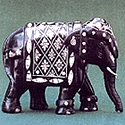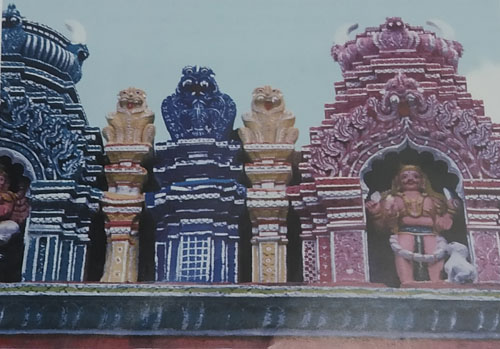Wood inlay is the process of decorating the surface of wood by setting in pieces of material such as ivory, bone, plastic, or wood of different colours. This craft is concentrated in Mysore and Bangalore in Karnataka where its roots can be traced back to a family by the name of Mirza Yousuf Ali who were pioneers in the field.
The artisan smoothens the base of the rose wood and the design is traced and etched into the surface. The several components of the inlay are painstakingly assembled to match and fit exactly into the grooves and are then glued in. The design is finished by obtaining the required shades with several coats of polish.
Examples of inlay work in Karnataka include the ivory inlay in rose wood and ebony in the Srirangapatnam mausoleum; the doors of the Amba Vilas palace in Mysore are also fine examples of inlay. Products with inlay include plates, boxes, bowls, cigarette cases, and figures of animals, especially elephants, which continue to be popular. The designs include floral and geometric patterns, landscapes, pastoral scenes, processions, and scenes from the epics.
Marquetry is a craft which has been patronised by the royals of Mysore. Under their patronage this craft flourished during the 17th century. A lot of exquisite marquetry can be seen in the indoor architecture of the Mysore palace. The height of the craftspersons’ skill can be seen in various door and window panels. The most astonishing story of this craft community is that many non Hindu artisans are involved in depicting elaborate stories from Hindu mythology.
Unlike many other crafts which received royal patronage, the wood inlay craft of Mysore is very much alive. Many fine arts students are drawn into practicing this craft. The Mysore Fine Arts College offers special course in wood inlay. The back streets of old Mysore are teeming with wood inlay workshops. More than 5,000 artisans earn their living from this craft. The Regional Design and Marketing Center (a Government organisation) offers various schemes to help these artisans.
The forests near Mysore are the major source of raw material for this craft. A number of timber merchants supply solely to the artisan community. The traditional use of rosewood as a raw material has become expensive and mango wood is often used as a replacement. This gives the artisans almost the same surface quality at a lower price. Also, mango wood enables the artisans to get nice grains. Designers have introduced MDF (medium density fibre) for the surface. MDF is a recycled board and the use of this board also helps in preventing deforestation.
In much the same manner in which horns and bones took the place of ivory, plastic sheets are now used instead of horns and bones as the inlay material. This enables the artisans to make inlayed products at a lower price and gives them the opportunity to explore other segments of the market. These plastics are available in plenty in the Mysore main market area and are available in a wide variety of thicknesses (1, 1.5, 2, 2.5, 3 millimetres).
The dimensions and the scale of the products to be produced are given to the artisans as sketches and colours are mentioned on these sketches. The artisan cuts the relief painstakingly in various coloured woods. These are joined temporarily with watered Fevicol (an adhesive). The carpenter works on the surface and he also cuts grooves on it to fit in the spliced pieces of wood. After the spliced wood is fitted on to the surface, it is nailed together for some time and then is sent for pressing. This pressing process is done by machine and takes about a day and a half. Once the pressing is complete, the article again comes back to the artisans for polishing. Polishing takes some amount of time. It is done with fine chisels and later on with sand paper.
Inlay artisans possess another fine skill, which is to scratch the surface and rub it with lampblack. This skill is used for producing very fine images such as eyes, eyebrows, hair, etc.
Designer-artisan interaction is a recent phenomenon in Mysore. Artisans have responded to the market need without the help of designers. They have started depicting various scenes on flat surfaces and making framed portraits of famous people, gods and goddesses. Small souvenirs like key rings, pen stands and small boxes cater to the mid range tourist market. Jewellery is also being produced and is a potential growth area.
Mysore inlay artists are doing well and the quality of their skill has certainly survived. However, a greater input from designers and architects is required to help them in exploring new markets and using inlay in new and innovative manners.
The beauty of Mysore inlay lies in the level of detail that is achieved. However, on the flip side detailing can also be regarded as unnecessary embellishment. If a greater volume of work is to be provided to the inlay artisans, they will have to be taught to do less inlay work while at the same time not to lose their expressiveness. Elaborate inlay worked products could be reserved for high-end markets.
Karnataka artisans are known for their intricate carvings of rose and sandalwood. They employ age-old techniques to carve, inlay, veneer, paint, and lacquer articles in wood. Traditionally, craftspersons in Karnataka inlaid rosewood and ebony with ivory, some of the finest examples of which can be seen in the Seringapatnam mausoleum and the doors of the Amba Vilas Palace in Mysore. Today different types of wood of different colours and shades and plastic are used as inlay material to depict themes from Hindu mythology, secular themes, birds, animals, landscapes, etc. The usual articles made in Karnataka are inlaid furniture items, powder boxes, bowls, puja mandaps, wall hangings, etc. Karnataka is known for its ivory inlay work. The ornamentation, which usually consists of geometrical, scroll or floral patterns, is produced by setting small pieces of ivory in different shapes into the design incised on a flat surface. Mysore is the only city in the state where wood inlay is produced. This exquisitely delicate craft consisted hitherto of ornamenting rosewood with ivory. But of late the emphasis has shifted to securing a happy and attractive combination of woods of different natural colours against a dark background. A wide range of articles are made by inlay workers at Mysore, among which mention may be made of panels, treys, pegs, tables, plates, boxes, powder bowls, and cigarette cases besides the dusserra pageantry, landscapes, and pastoral scenes.
Gallery
YOUR VIEWS
PRACTITIONERS: INDIA
Access 70,000+ practitioners in 2500+ crafts across India.
BIBLIOGRAPHY
10,000+ listings on arts, crafts, design, heritage, culture etc.
GLOSSARY
Rich and often unfamiliar vocabulary of crafts and textiles.
SHOP at India InCH
Needs to be written.






